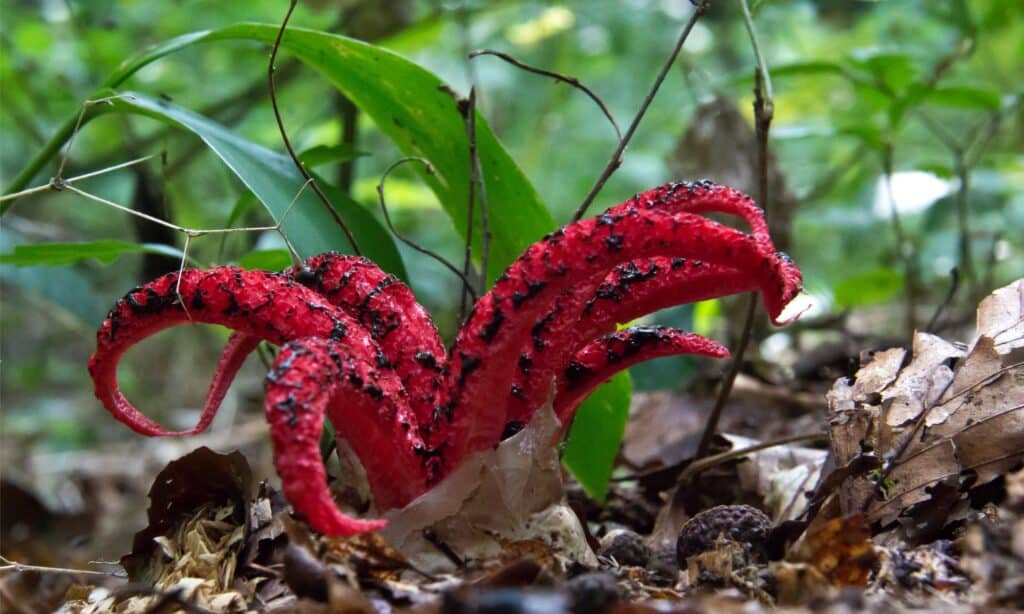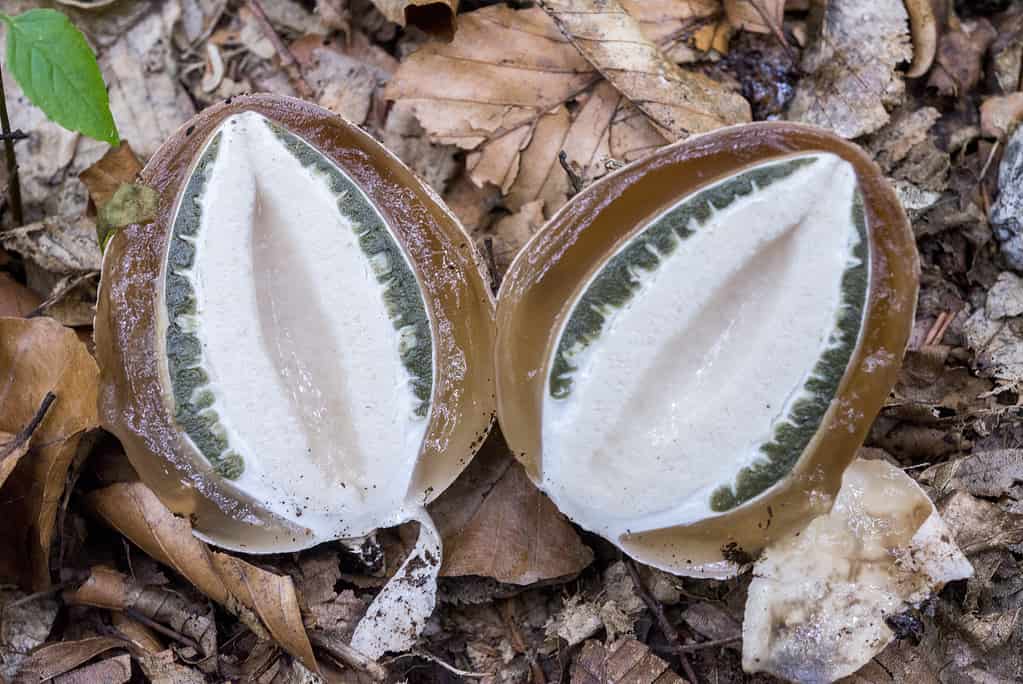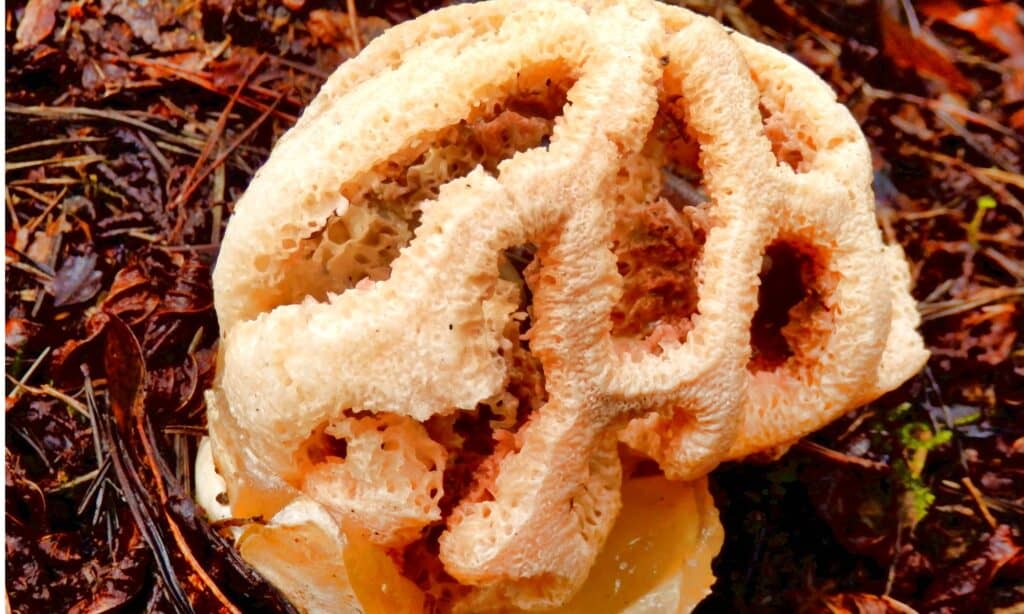If stinkhorn fungi are appearing in your yard, you may be a bit put off by their pungent smell, and wondering how to remove them. While this may be a fair question, it’s also crucial to consider and understand the ecological role these fungi play before deciding on whether to try to remove the fruiting bodies from your yard. It’s also critical to understand whether you really can successfully remove these fungi from your landscape.
In this guide, we’ll describe the classification of stinkhorns, their characteristics, ecological roles, toxicity status, human uses, and the feasibility of removing them from an area.
Read on to learn more.
Stinkhorn Fungi: Fungal Classification and a Brief Intro

©iStock.com/LeoMalsam
Before we talk about how feasible stinkhorn removal is (or isn’t), we’ll dive into the classification, characteristics, distribution, ecological roles, toxicity, and human uses of these fascinating fungi. This information may help you form a more holistic understanding of these mushrooms, as opposed to seeing them as merely a nuisance to eradicate.
Fungal Classification
Mushrooms with a potently smelly reputation, stinkhorns represent an amazingly diverse group of fungi in the Phallaceae family of the Phallales order. The stinkhorn family contains at least 21 genera, with at least 77 species. They are quite unique in their various array of the fruiting bodies’ shapes and colors.
Characteristics
A defining characteristic of all stinkhorns is their spore dispersal strategy. For most mushrooms, spore dispersal is achieved through a 2-phase process. First, the mushroom ejects the spores beyond the spore dispersal tissue into the air (active phase). Then the wind then disperses them (passive phase). Rather than relying on wind for dispersal, the stinkhorn fungi have evolved an entirely different strategy. For these unique fungi, their method involves producing a thick, slimy, and revoltingly (to our noses) smelly spore-bearing tissue, called a gleba, which attracts a range of insect species. These insects, such as flies, eagerly consume the slime at the top of the fruiting body, inadvertently covering themselves with spores to disperse as they move throughout their environment.
Additionally, all stinkhorns begin their fruiting phase as immature egg-like structures that emerge from a portion of the mycelium called a rhizomorph. From the egg, the fruiting body emerges in various hollow, spongy forms from octopus-shaped to phallic, anemone, and wiffle ball-shaped. Example species of these forms, respectively, are Clathrus archeri, Phallus hadriani, Aseroe rubra, and Clathrus crispus.
Some have fruiting bodies that look like folded tentacles (Clathrus columnatus). Some even feature rather stunning, lacy “skirts” that emerge from the bottom of the cap and expand outward, surrounding the stem (Phallus indusiatus). Common colors of stinkhorns include various shades of red, orange, yellow, beige, brown, and white.
Stinkhorn Fungi Distribution and Ecological Roles
Stinkhorn fungi have a worldwide distribution (except Antarctica), appearing mostly across tropical and subtropical regions. In North America, some species are native while others have become naturalized, even in cooler temperate regions. Some examples of North American species include Phallus impudicus and Phallus hadriani. The anemone or starfish stinkhorn, Aseroe rubra, is naturalized to warm regions of the US, although it is technically not native.
As saprotrophic fungi, stinkhorns play a crucial ecological role as decomposers. While they may just seem like smelly fungi taking over your yard, attracting flies, and then disappearing, these decomposers are crucial to the health of the soil by breaking down dead plant material, thus returning essential nutrients to the ground.
You’ll often find stinkhorns popping up in moist, decomposing material such as mulch and leaf litter. You can also commonly come across them in gardens, flowerbeds, and meadowy areas. When stinkhorns appear in your yard, they often seem to pop up overnight. This is due to the rapid growth rate of the fruiting bodies. Some species able to grow between 4-6 inches in one hour.
Toxicity
For some folks, stinkhorns can look a bit shocking in addition to their pungent smell. This can lead to the assumption that these fungi are poisonous. Currently, and while this may come as a surprise, the consensus among mycologists and toxicologists is that stinkhorns are not poisonous to humans or pets. So, while you may feel repulsed by their smell, it’s important to know that they won’t harm you other than insulting your olfactory sense.
Human Uses
You might imagine that humans could find no use in fungi that release the scent of rotting flesh. But actually, several species, such as Phallus impudicus and Phallus ravenelii, are edible when in their immature egg stage. In this immature phase, stinkhorns are often referred to as witch’s eggs. They are a delight to forage for the brave mycophagist.
While they may not be a common edible, particularly in North America, it’s important to understand toxic look-alikes if you do decide to give foraging the eggs a try. Of course, if you’re a beginner forager, the best practice is to accompany a mushroom expert on outings.
Look-Alikes of Stinkhorn Fungi Eggs

©Edvard Mizsei/Shutterstock.com
The biggest look-alike threats are immature species of poisonous mushrooms. Some deadly toxic mushrooms, such as amatoxins-containing amanitas like Amanita bisporigera, form immature fruiting bodies encased in a protective universal veil that resembles an egg.
To confirm you have found an immature stinkhorn, cut it in half lengthwise. A stinkhorn egg will feature a rather lovely cross-section of colors that vary depending on the species. As you can see above, the cross-section of a common stinkhorn (Phallicus impudicus) egg reveals a firm, protective tan-brown outer band. Then, a gel-like section of olive green-brown (the gleba). Finally, the innermost section (the developing stem, aka the stipe) is white.
In contrast, a cross-section of an immature white amanita (or other gilled mushrooms) that is encased in a universal veil will clearly show the developing stem, cap, and gills of the specimen. If you are in doubt about whether you have found an immature stinkhorn egg or a mushroom encased in a universal veil, absolutely do not take the chance. Instead, take the time to learn from an expert source (ideally in person) before foraging for consumption.
If you have 100% confirmed that you’ve found stinkhorn eggs, you have a few options for cooking them. One method of preparation is to remove the skin and gleba. Then, cut them into chunky slices, and fry ’em up. Some people also pickle them for use as toppings in salads and soups.
So, Can and Should You Try to Remove Stinkhorn Fungi?

©iStock.com/PlazacCameraman
If, after learning all about the wonderful world of stinkhorn fungi, you still want to try to remove them from your yard, the truth is that there isn’t much you can do. The majority of the fungus lives within a substrate as a branching network called mycelium. This substrate may be all of your mulch or major parts of your lawn. When that mycelium is ready, it produces fruiting bodies, which are the reproductive portions of fungus. While you can pluck stinkhorn fungi from your yard whenever you see them crop up, that’s about all you can do. The mycelium will continue to produce its reproductive structures. And remember, these fungi aren’t parasitic to plants, aren’t toxic to people or common pets, and play an important ecological role as decomposers.
So, yes, while they are certainly smelly, they can also be quite stunning in their various forms and colors. If you were concerned about whether your children are safe around stinkhorns, you now know that they aren’t toxic. Instead, you can use the presence of these mushrooms to teach your kiddos how organisms that we might find repulsive can still be important parts of our ecosystem that deserve our respect and understanding.
The post How to Get Rid of Stinkhorn Fungi appeared first on AZ Animals.
from Animal News, Facts, Rankings, and More! - AZ Animals https://ift.tt/OxZAUqV